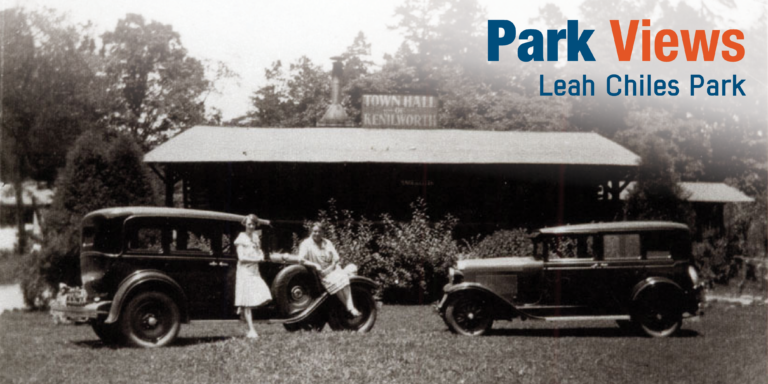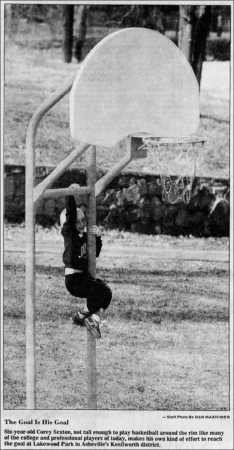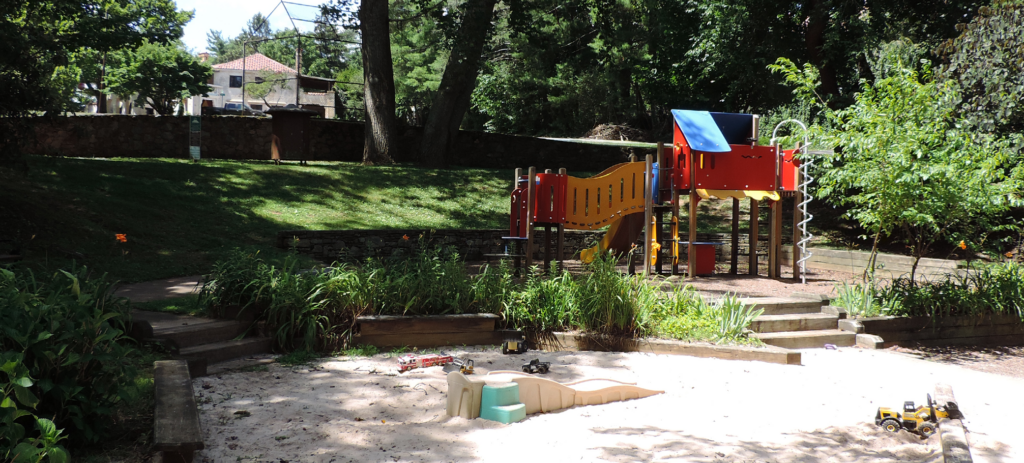This entry is part of Park Views, a weekly Asheville Parks & Recreation series that explores the history of the city’s public parks and community centers – and the mountain spirit that helped make them the unique spaces they are today. Read more from the series and follow APR on Facebook and Instagram for additional photos, upcoming events, and opportunities.
Leah Chiles was the first woman mayor in western North Carolina and the last mayor of the town of Kenilworth. In 2018, Lakewood Park was renamed Leah Chiles Park in her honor to inspire new generations of Ashevillians with her life of community leadership, entrepreneurial spirit, and advocating for the arts.
Town of Kenilworth
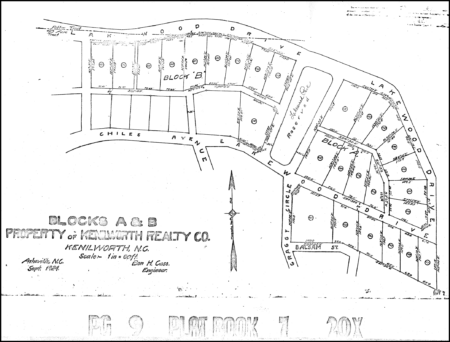 James “Jake” Madison Chiles had already owned a successful general store and furniture business when he arrived at the depot in Best (known today as Biltmore Village) in 1908. His destination was the original Kenilworth Inn, sitting on a hill above the railroad and surrounded by rolling hills and a wooded forest. Described as a man of vision and energy, he decided to move his furniture business to the booming area that was attracting investors and developers from Florida, Pennsylvania, and other parts of the country.
James “Jake” Madison Chiles had already owned a successful general store and furniture business when he arrived at the depot in Best (known today as Biltmore Village) in 1908. His destination was the original Kenilworth Inn, sitting on a hill above the railroad and surrounded by rolling hills and a wooded forest. Described as a man of vision and energy, he decided to move his furniture business to the booming area that was attracting investors and developers from Florida, Pennsylvania, and other parts of the country.
Soon after, Chiles sold his shares in United States Furniture Company and settled into a real estate career. When Kenilworth Inn burned to the ground in 1909, he formulated a plan to rebuild it surrounded by a British-inspired village. He sold a large tract of his land to the federal government to establish the VA medical center in Oteen and used the profits to establish Kenilworth near Asheville. Legend has it that he let his horse lead him around the property and used those meandering hoof prints to map streets inspired by names from Sir Walter Scott’s historical romance novel Kenilworth. Lots in the development sold well and he was elected the first mayor of the town.
On the east side of Beaucatcher Mountain, Kenilworth established its own police and fire departments, football team, and annual festivals. Its town hall was a log house on Caledonia Road that also contained its jail.
Leah Arcouet Chiles
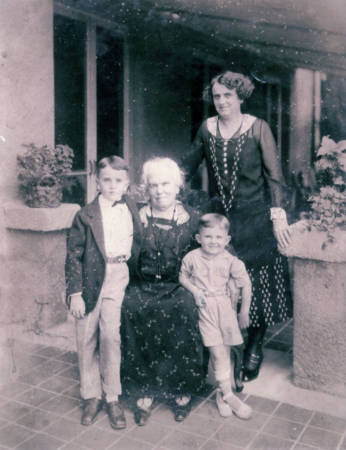 Leah Arcouet was born in Illinois to French immigrants in 1885. Her father, Casemier, was a sculptor who helped fashion the Statue of Liberty’s hands, Central Park’s fighting eagles, and Grand Central Station’s lioness and prey in New York City. He taught his daughter to paint and develop photographs while her mother also encouraged her to become a professional pianist. Following her father’s death, she took over his Chicago studio at 18 years-old, established herself as an accomplished artist in her own right, taught painting courses, and appeared on the concert stage.
Leah Arcouet was born in Illinois to French immigrants in 1885. Her father, Casemier, was a sculptor who helped fashion the Statue of Liberty’s hands, Central Park’s fighting eagles, and Grand Central Station’s lioness and prey in New York City. He taught his daughter to paint and develop photographs while her mother also encouraged her to become a professional pianist. Following her father’s death, she took over his Chicago studio at 18 years-old, established herself as an accomplished artist in her own right, taught painting courses, and appeared on the concert stage.
After relocating to Alabama to treat her mother’s respiratory problems, she decided to move to Asheville for its warmer climate and opened a studio on Pack Square. Leah and Jake married in 1914, the same year Kenilworth began advertising lots for sale. In 1922, they moved with their two sons into a sprawling Spanish Colonial Revival Style (arquitectura neocolonial española) home on Chiles Avenue directly across the street from the location of Leah Chiles Park. She took cues from the house features and painted Mediterranean-inspired murals in her husband’s office.
As lively as her husband and already heavily involved in the business, she took over Kenilworth Development Company when he died suddenly in 1925. She organized star-studded art shows at the rebuilt Kenilworth Inn to promote the community, drawing on her father’s reputation to display canvases from Boston and Chicago museums and calling on Cornelia Vanderbilt to cut the ribbon at the first show.
Chiles organized Easter community egg hunts and appeared as Santa Claus atop the town’s fire truck during the annual Kenilworth Christmas parades. She designed and drove the town’s entry in Asheville’s Rhododendron Festival of 1928, winning first prize. When she traveled to Florida, she wrote slogans on her vehicle promoting tourism in the Kenilworth and Asheville area. She was elected mayor in 1928 and immediately set about work to complete Kenilworth’s public parks.
With the economic collapse of 1929, Asheville tapped smaller neighboring communities for annexation to consolidate revenue and services. Oakley and West Asheville agreed; Biltmore Forest declined. Chiles recognized Kenilworth would very likely become part of the larger city, but refused to bow without voters’ approval. Residents chose by one vote to become a part of Asheville. Mayor Chiles submitted a document declaring the independent town of Kenilworth was “condemned to die on June 30, 1929, to the bigger, better, and wealthier City of Asheville.” The town would become known as the Kenilworth neighborhood and still maintains much of its original style.
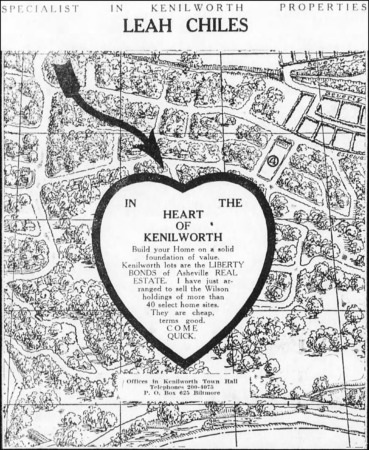 After that, she concentrated on work and her sons, Richard and John. Chiles became one of the founding members of Appalachian handicrafts and décor company Three Mountaineers, remaining a strong influence until her death in 1953 at 68.
After that, she concentrated on work and her sons, Richard and John. Chiles became one of the founding members of Appalachian handicrafts and décor company Three Mountaineers, remaining a strong influence until her death in 1953 at 68.
Leah Arcouet Chiles let nothing get in her way. When she was told women could not become ambulance drivers because they were unable to handle extreme conditions, she traveled to New York City by train, bought an Oldsmobile, and spent six days driving back to Asheville by herself, carrying her own gas, navigating mudslides and mountains.
One famous footnote in her colorful life involves Asheville’s proposal to buy Kenilworth’s fire truck prior to annexation. She wanted $3,000, but only $500 was offered. She scheduled a water duel between the two fire departments in Pack Square. Kenilworth won and she sold the fire truck to another buyer.
 Lakewood Park
Lakewood Park
According to its deed, the land for Lakewood Park was donated to the town of Kenilworth on December 30, 1924 for permanent use as a public park. It was primarily an ornamental space featuring bushes, flowers, shade trees, and grassy areas for town members to contemplate in nature and connect with each other.
In the 1970s, Kenilworth residents petitioned for a series of recreation improvements using Housing and Community Development Act funds including bike and hiking trails, a new mountainside park on Beaucatcher Mountain, tennis courts in Kenilworth Park, and a picnic shelter in Lakewood Park. Asheville Parks & Recreation (APR) installed a backstop on the upper open lawn of Lakewood Park for batting practice and pickup games and new playground equipment, basketball court, and picnic area in the lower section.
The revitalized park hosted annual events including Sundays in the Park and Summer Fun Run, as well as APR’s Rec n Roll play van for many years. By the mid-1990s, parents advocated for the park to add more options for toddlers. At that time, the play space included a wading pool, slide, buck-a-bout, bouncing animals, exercise swings, and basketball court.
With early leadership from Quality Forward (now Asheville GreenWorks) and funding from APR, Kenilworth Residents Association, and Kiwanis Club of Asheville, hundreds of volunteers helped open a renovated park with accessible areas, picnic tables and benches, and a toddler playground with swings, climbing area, sandbox, and halfcourt basketball. Kiwanis Club of Asheville received the top service award in the Carolinas District for the project.
Leah Chiles Park
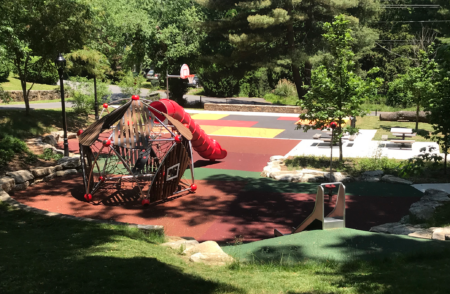 Following overwhelming support from Asheville voters for a bond referendum supporting parks and recreation facilities improvements, playgrounds throughout the city were renovated or replaced. During the community engagement process, the current owners of the Chiles House proposed a name change to the park that was unanimously approved by City Council in 2018. They also donated an historical marker with information about its namesake to be installed at the park. Several of Leah and Jake’s descendants attended the unveiling ceremony.
Following overwhelming support from Asheville voters for a bond referendum supporting parks and recreation facilities improvements, playgrounds throughout the city were renovated or replaced. During the community engagement process, the current owners of the Chiles House proposed a name change to the park that was unanimously approved by City Council in 2018. They also donated an historical marker with information about its namesake to be installed at the park. Several of Leah and Jake’s descendants attended the unveiling ceremony.
When Leah Chiles Park reopened, it featured greater accessibility, areas for kids of all ages to slide and climb, and an artistic take on the basketball area while preserving the well-loved upper lawn and repairing the iconic stone wall between its two sections – fitting for a woman who cares about art, community, and family.
Do you have photos or stories to share about Leah Chiles Park? Please send them to cbubenik@ashevillenc.gov so APR can be inspired by the past as we plan our future.
Photo and Image Credits
- Leah Chiles (seated) poses with her secretary, Mrs. Ward, in front of Kenilworth’s town hall. Though it had been incorporated in 1891 (when the original Kenilworth Inn was essentially the entire town), Kenilworth’s development accelerated in the final years of an area boom that attracted attention for the quirky and decadent lifestyles of some of its wealthier residents. The log cabin had previously served as a general store and was also used as a jail. From the family scrapbook of John Chiles. Courtesy of Buncombe County Special Collections, Pack Memorial Public Library, Asheville, North Carolina.
- Lakewood Park (now Leah Chiles Park) was included in the development’s plans from the beginning. Local legend says the streets of Kenilworth were laid out in an unconventional way. According to John Chiles, when developers and engineers could not agree on the layout, Jake Chiles got on his horse Frank, loosened the reins, and let him take the lead. He then told the engineers to “build the roads where the hoofs are.” Original plans called for Kenilworth to include a golf course on land that had been part of the Patton family’s plantation, but after a trip to England, Jake decided (against his business partners’ wishes) to create a lake in its place to mimic castle moats.
- This Chiles family portrait includes (left to right) Richard “Dick,” “Grannie” Marie Arcouet, John, and Leah in front of the Chiles House across from the park. Though she was a respected and effective businesswoman, family was also very important. From the family scrapbook of John Chiles. Courtesy of Buncombe County Special Collections, Pack Memorial Public Library, Asheville, North Carolina.
- A 1926 real estate ad in The Asheville Citizen may not have been completely true, but shows Leah’s penchant for marketing. With close proximity to Biltmore, Kenilworth home sites were not what would have been considered “cheap” by most, but they offered a good return for those who invested early.
- The park’s playground has been through multiple transformations. At one point, it featured a jungle gym, but that may have been removed by the time this tyke decided to scale the basketball goal in this photo from Asheville Citizen-Times.
- The late-1990s renovation would relocate the basketball court to the former location of a wading pool, consolidate the playground on the previous site of the court, create a sandbox, and add paved surfaces to make the park more accessible.
- Now known as Leah Chiles Park, the space has been completely renovated with a modern look, rubberized safety surface on the playground, and more opportunities for people of all ages to enjoy the park.
